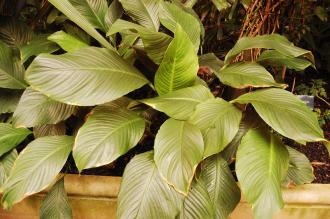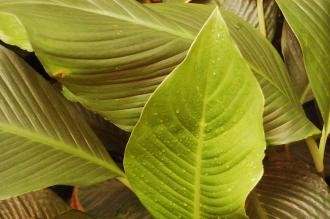
Spathiphyllum cannifolium (16/01/2016, Kew Gardens, London)
Position: Indirect bright light
Flowering period: All year round
Soil: Moist, well drained
Eventual Height: 60cm
Eventual Spread: 90cm
Hardiness: 10b, 11, 12, 13
Family: Araceae
Spathiphyllum cannifolium is a tropical evergreen herbaceous perennial with a clump forming habit. Its dark green glossy leaves are ovate with entire margins, up to 50cm long and 20cm across. Its fragrant flowers are composed of a cream coloured spathe (bract) and a yellow spadix, are up to 7cm long and appear on a flowering stalk. Its roots have rhizomes from which its leaves and flowers emerge.
Spathiphyllum cannifolium, commonly known as Peace Lily or Spathe Flower, is native to north South America and the Caribbean island of Trinidad. In its native habitat it grows as an understory plant in tropical forests.
The etymological root of the binomial name Spathiphyllum is from the Greek spaqh meaning ‘broad blade’ and phylum meaning ‘leaf’. Cannifolium is derived from the name of another genus, Canna and the Latin floium ’leaf’.
The landscape architect may find Spathiphyllum cannifolium useful as a foliage houseplant with attractive flowers suitable for shady locations. It should be noted that this plant will produce fewer flowers in lower light levels.

Spathiphyllum cannifolium Leaf (16/01/2016, Kew Gardens, London)
Ecologically, Spathiphyllum cannifolium are of little benefit to UK wildlife.
Spathiphyllum cannifolium prefers moist, fertile, well-drained soils. It tolerates most pH of soil.
When maintaining Spathiphyllum cannifolium as a houseplant its soil should be watered regularly (not wet). Watering should be reduced during the winter months. Its preferred active growing temperature rages from between 18ºc to 30ºc, although it will tolerate a low temperature of 16ºc. Feeding with weak fertiliser solution should be carried out every two weeks during the growing season. To keep a tidy appearance old flowered and flower stalks can be removed. It likes to be misted regularly and its leave being wiped clean. Red Spider Mite, Scale insects and mealy bugs may attack this plant.

Landscape Architecture

